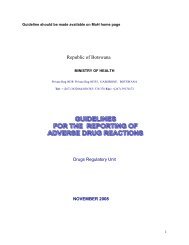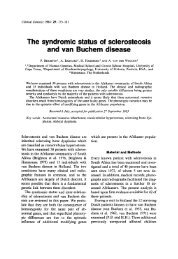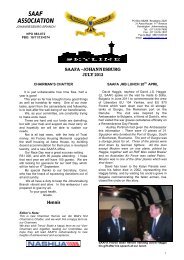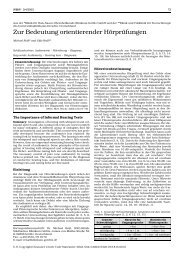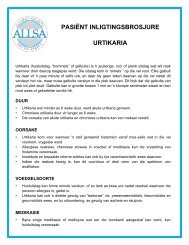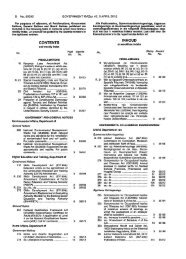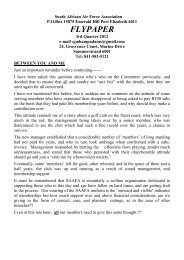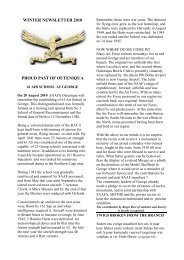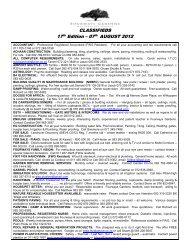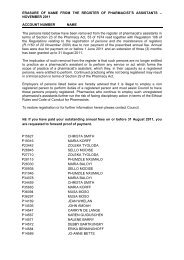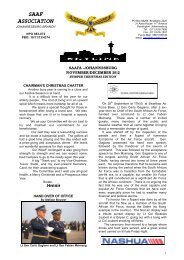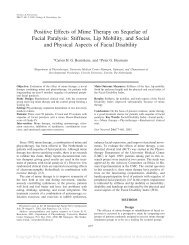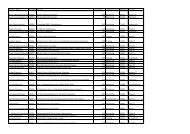Bell's Palsy: The Spontaneous Course of 2,500 Peripheral ... - Admin
Bell's Palsy: The Spontaneous Course of 2,500 Peripheral ... - Admin
Bell's Palsy: The Spontaneous Course of 2,500 Peripheral ... - Admin
Create successful ePaper yourself
Turn your PDF publications into a flip-book with our unique Google optimized e-Paper software.
Bell’s palsy 23<br />
Seasonal variation and clustering<br />
No seasonal variation or clustering was evident in<br />
this sample and furthermore no variation from year<br />
to year or from one decade to another could be<br />
demonstrated (Fig. 1). Adour et al. (75) did not<br />
observe signi cant differences in the number <strong>of</strong> cases<br />
occurring during the cold and warm seasons and<br />
neither did they report any epidemic incidence. Devriese<br />
et al. (76) reported that far more cases <strong>of</strong> Bell’s<br />
palsy were seen during the last 3 months <strong>of</strong> the year.<br />
Parry and King (81), in a 25-year study including 516<br />
patients, found a slight, but non-signi cant, tendency<br />
for the condition to be more common during the<br />
winter months. Park and Watkins (48) found no<br />
statistically signi cant seasonal variation in a sample<br />
<strong>of</strong> <strong>500</strong> cases. Leibowitz (82) analyzed the time distribution<br />
<strong>of</strong> 499 consecutive cases <strong>of</strong> Bell’s palsy and<br />
found it to be statistically different from the distribution<br />
<strong>of</strong> independent cases, because the cases appeared<br />
in clusters. <strong>The</strong> explanation for the nding <strong>of</strong> seasonal<br />
variation or clustering in some samples could<br />
be that the number <strong>of</strong> patients was too small. <strong>The</strong><br />
lack <strong>of</strong> seasonal variation must be noted but exerts<br />
no in uence on the etiology, even if it de nitely<br />
eliminates any possibility <strong>of</strong> epidemic viral infections.<br />
Sex distribution<br />
<strong>The</strong> question <strong>of</strong> a gender predominance among patients<br />
af icted with idiopathic facial palsy has been<br />
discussed in the literature, without any conclusions<br />
being drawn. One <strong>of</strong> the main reasons for the discussion<br />
has again undoubtedly been the small amount <strong>of</strong><br />
material available. This investigation included 1,701<br />
patients with Bell’s palsy, 818 <strong>of</strong> whom were male<br />
and 883 female, a gender ratio equal to that in the<br />
general population. In almost all trials no comparison<br />
has been made between the sex distributions in<br />
the patients and in the general population. Adour et<br />
al. (75) found the proportions <strong>of</strong> males and females<br />
with Bell’s palsy to be about equal. Devriese et al.<br />
(76) reported more men than women in their sample<br />
but the difference was not signi cant and no comparison<br />
was made with the general population. In<br />
contrast, Park and Watkins (48) found palsy to be<br />
more frequent in women than in men; however, again<br />
the sex distribution was not compared to that in the<br />
general population and the study included only 450<br />
patients.<br />
Side <strong>of</strong> the face<br />
<strong>The</strong>re is no disagreement in the literature about this<br />
aspect <strong>of</strong> Bell’s palsy. <strong>The</strong> largest patient samples (75,<br />
76, this study) show no signi cant difference in the<br />
number <strong>of</strong> palsies <strong>of</strong> the right and left sides <strong>of</strong> the<br />
face.<br />
Age distribution<br />
This study showed that the incidence <strong>of</strong> Bell’s palsy<br />
reaches a maximum between the ages <strong>of</strong> 15 and 45<br />
years and that the disease is signi cantly less common<br />
below the age <strong>of</strong> 15 years and above 60 years <strong>of</strong> age.<br />
It should be stressed that it is very important to<br />
compare the age distribution <strong>of</strong> the patients with that<br />
<strong>of</strong> the underlying population, because the different<br />
age groups are not <strong>of</strong> equal size. In spite <strong>of</strong> this, the<br />
largest series (48, 63, 75, 76) showed the highest<br />
frequencies <strong>of</strong> Bell’s palsy in the second, third and<br />
fourth decades.<br />
Time <strong>of</strong> beginning recovery and nal outcome<br />
<strong>The</strong> number <strong>of</strong> days between the onset <strong>of</strong> paresis and<br />
the beginning <strong>of</strong> remission <strong>of</strong> function is a very<br />
crucial time, during which the fate <strong>of</strong> the nerve is<br />
determined (Fig. 7). In this study, 94% <strong>of</strong> patients<br />
with incomplete paresis experienced full recovery. Of<br />
those who showed signs <strong>of</strong> remission in the rst and<br />
second weeks, 88% and 83%, respectively experienced<br />
full recovery. <strong>The</strong>re was no signi cant difference in<br />
outcome between patients who showed signs <strong>of</strong> remission<br />
in the rst and second weeks, but remission<br />
in the third week was associated with a signi cantly<br />
worse outcome (61%). After 3 weeks a period without<br />
remission occurred which lasted until :3 months<br />
after the onset <strong>of</strong> the palsy and this is referred to as<br />
‘‘the hibernation <strong>of</strong> the facial nerve’’. <strong>The</strong>se patients<br />
underwent total degeneration and did not regain<br />
normal function, as previously stressed by Taverner<br />
(68) in 1965.<br />
Ramsey et al. (66) concluded that the literature<br />
clearly shows that virtually all patients with clinically<br />
incomplete paresis have excellent recovery <strong>of</strong> facial<br />
function, independent <strong>of</strong> treatment: in this study a<br />
rate <strong>of</strong> 94% was found, Parry and King (81) found a<br />
rate <strong>of</strong> 96% and Sittel et al. (69) a rate <strong>of</strong> 98%. In the<br />
group with initially complete Bell’s palsy in this<br />
study, 61% regained normal facial muscle function.<br />
In contrast, Ramsey et al. (66) did not ‘‘expect’’ to<br />
observe full recovery in \40% <strong>of</strong> the patients with<br />
paralysis. Steroid treatment was ‘‘expected’’ to improve<br />
the recovery rate to :57%. <strong>The</strong>refore there<br />
seems to be no difference between the percentage <strong>of</strong><br />
recovery observed in the present study and in the<br />
steroid-treated patients.<br />
Age-dependent recovery<br />
Age is another parameter that in uences the nal<br />
result (Fig. 8). Children have the most favorable<br />
prognosis, with 90% experiencing full recovery.<br />
Above the age <strong>of</strong> 60 years, only about one-third <strong>of</strong><br />
patients will experience the return <strong>of</strong> normal function.<br />
Adour and Wingerd (83) described a worse



